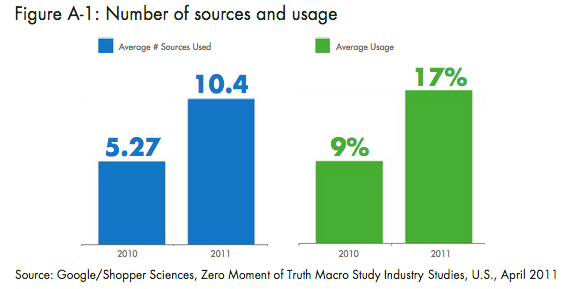Google's research on the Zero Moment of Truth continues to amaze me, and there's a stat I've called out before that is worth revisiting. It's this:

In 2010, people looked at an average of 5.2 pieces of information before purchasing. By 2011, it had doubled to 10.4.
That’s huge.
Even if you don’t extrapolate it out and think of it as constant, that’s still a lot. Ten pieces of information before a purchase. That’s an average, so there’s a considerable amount of people who need more information before they make a purchase. Not to mention, this is across all verticals. Is what your company does more or less complicated than average?
Thinking about the implications, you start to see why you must begin developing a content strategy. People are going to look for content before they buy, so you need to have skin in the game. Each individuals path will be different as well, so you'll need content that appeals to different types of buyers.
One of the best examples of this is Marcus Sheridan. He runs a pool installation company and found out a few years ago that blogging was a huge boon to his business. The first thing he did was sit down with his sales team to write out every question they had ever been asked. Then he started writing blog posts about the most common ones.
After having been at it for a few years, he’s gotten a little more advanced with his measurements on how effective blogging has been for him. He’s had $1.2 million worth of sales attributed to one blog post.
He also knows that once a person has read 30 posts on his site, he has an 80% close rate. How powerful could that type of information be for your organization?
The reason that people want to look at so much before they buy is that consumers have become conditioned to finding all of the information they’re looking for online. People are waiting until the very last moment to speak to a salesperson, if they have to speak with a salesperson at all. If a prospect can’t find something, do you think they’ll fill out a contact form, or will they just go back to Google and end up at a competitor’s site?
Jumpstarting Your Content Strategy
If you’re a company that suddenly finds yourself in a content deficit, there’s a lot you can do to quickly get up to speed. You can similarly sit down with your team and come up with the most common questions that customers ask. Rank them in terms of frequency and importance in the buying process. Then divide and conquer.
This can help create a sudden body of information that customers can read, and that search engines can index. You can even create offers on many of them to try and generate leads. Plus it establishes you as an expert on the matter. That can make a big difference.
Not to mention it helps offset growing search engine marketing costs, as many businesses have noted. As your company has an established web presence, it can help you lower your paid costs to attract visitors to your website. If you use a tool like HubSpot, you can even track the dollar amount of the terms you’re trying to own.
Google does this type of research to help businesses understand that people are finding a lot more of their information online before they ever enter a store. Customers want to do more research online before they enter a store, or reach out to a sales rep. Develop content online to match their research habits, and you’ll not only get more customers, but better educated ones as well.





